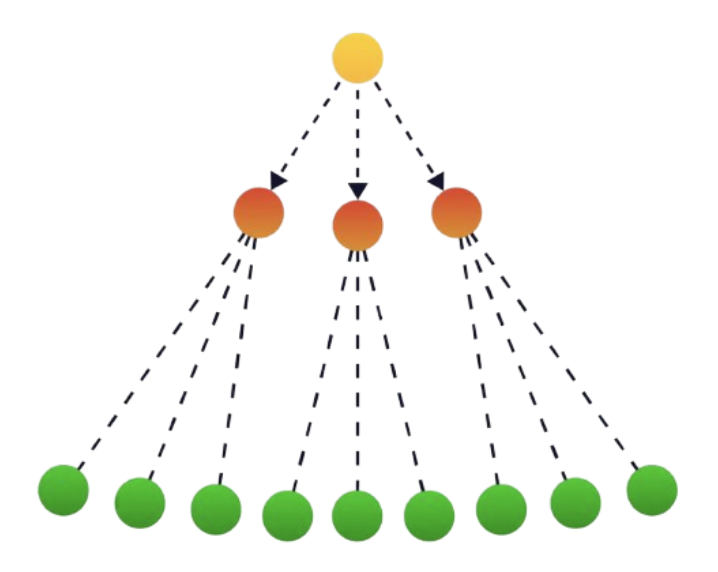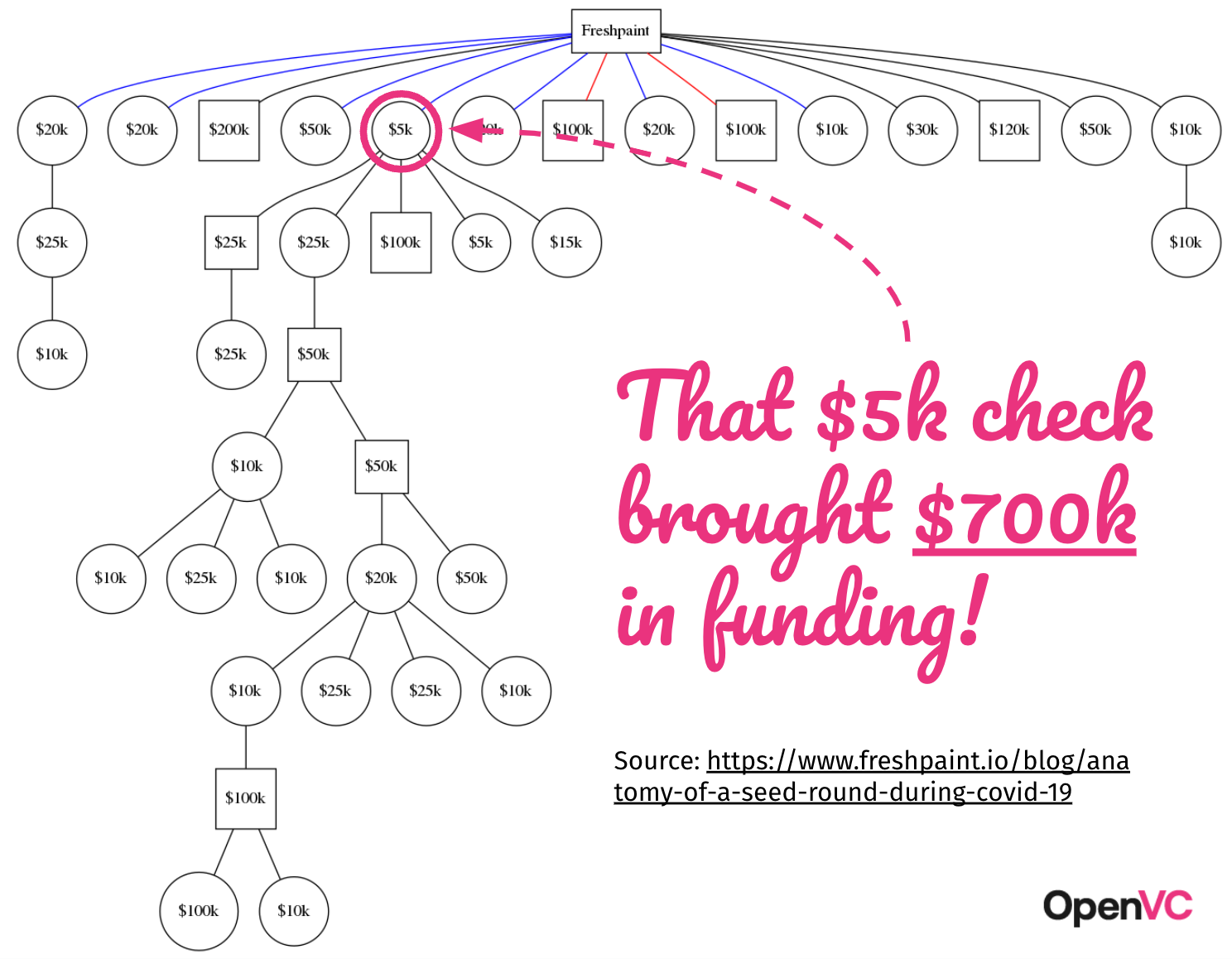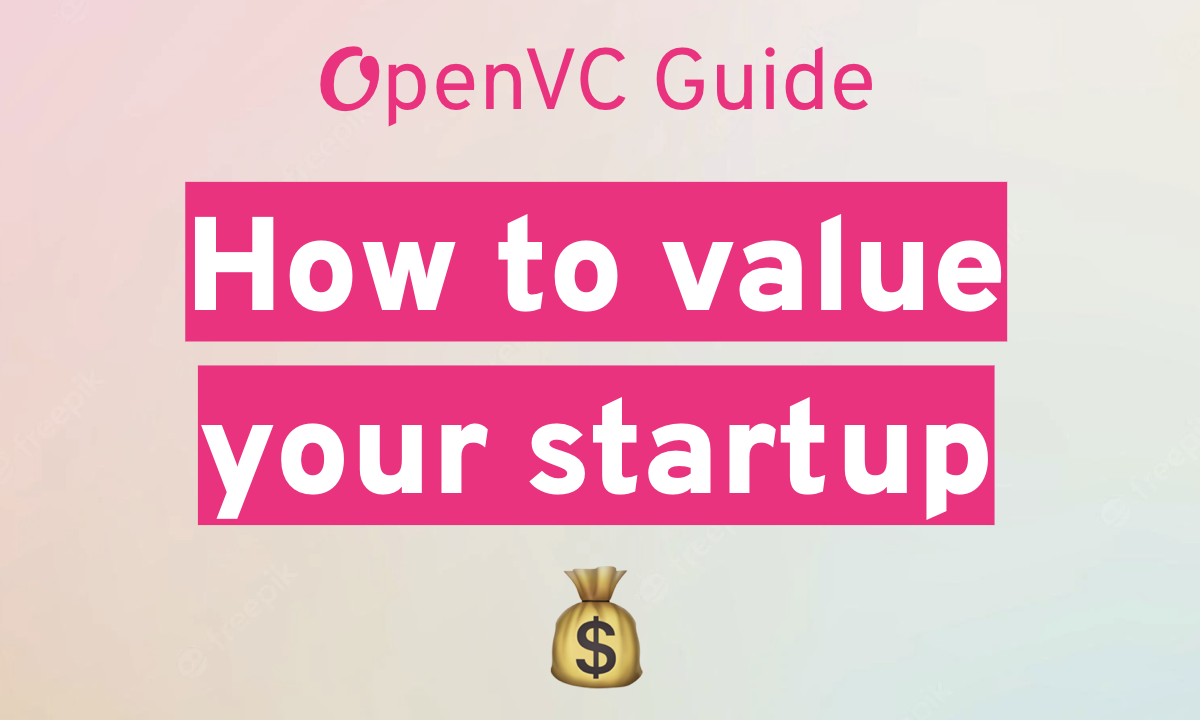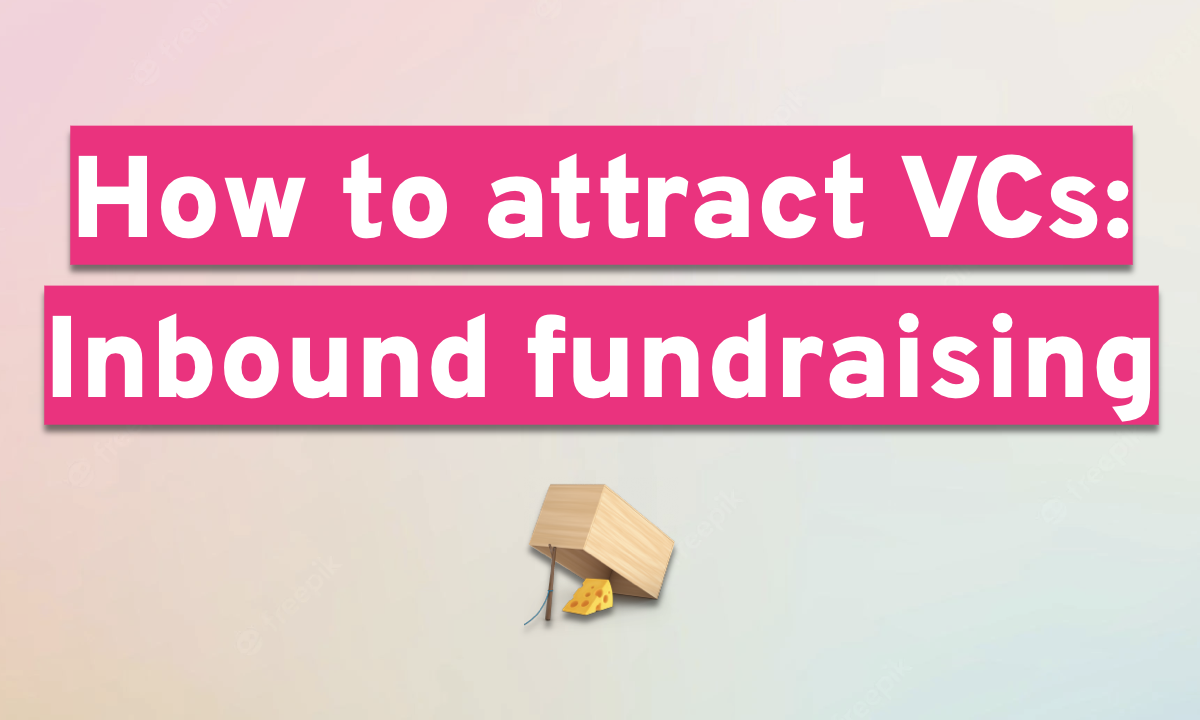Warm intros are the cornerstone of today's fundraising, for better and for worse.
So how do you get 1 intro? Or even 100?
This post will tell you everything you need to know about warm intros to VCs.
Table of Contents
I. Warm intros are the cornerstone of today's fundraising
An intro is when a founder gets connected to an investor via a third party, let's call him/her a “connector”.
A good intro requires double opt-in, meaning that the connector will get approval from both sides before proceeding.
Most intros today happen via email. They look something like this:

Intros are by far the most effective way to get funded.
A report from 2017 found that a warm introduction leads to 13x higher chances of funding than a cold email.
It's not a small difference, it's a humongous gap!
But why are intros so powerful?
Because investing is a social act. At early stage, there's little tangible data to make an investment decision. Therefore, the decision process is prone to “soft” signals, like other people's opinion.
So yeah, warm intros are good.
But what happens when you can't get intros?
Unlock the secrets to startup fundraising 🚀
Use our FREE, expert-backed playbook to define your valuation, build VC connections, and secure capital faster.
Access now
II. Are warm intros evil?
Most founders don't have connections, can't get warm intros, and therefore, are excluded from venture capital.
This led people like Del Johson to call for a ban on warm intros. In Del's own words, “Intros promote exclusion while simultaneously lowering financial returns on the fund and asset level.”
True, intros are unequal. And true, some people enjoy an advantage they don't deserve.
But I'd like to nuance that perspective:
- An intro doesn't guarantee you will get funded. It gets you a better look at your deck, and maybe the first meeting. That's pretty much it.
- An intro can definitely be earned. Some founders spend a decade in a specific market or industry, accumulate a successful track record, and prove their worth to their peers. Getting intros is a natural side effect of that journey.
Jensen Huang, CEO of Nvidia, is a case in point. He got his first check from Sequoia Capital thanks to a referral from his former boss Wilf Corrigan:
The key point here is "one of the best employees I've ever had".
A more recent example is Andrew Rea from Taxwire:
Andre sums it up well: work hard alongside key people, get recognized for your worth by these "super-connectors", and when the time comes, you'll have access to capital.
This is the unspoken truth of warm intros: you should have started 10 years ago.
By the time you get to fundraising and realize it, it's too late. You may build a network in a year or two, but you won't build it overnight. So much for your pre-seed closing in 2 months…
This is a bleak perspective for enthusiastic, hard-working, but non-networked founders. You want to run the race, but aren't even allowed on the starting blocks. Extremely frustrating.
Extremely frustrating.
III. How to maximize your warm intros
Let's get to the practical part of this post: how to get intros, how to get more intros, and how to get quality intros.
1. Make sure you're fundable before asking for intros
First mistake: asking for intros when you are objectively not fundable yet.
When someone makes an intro, their reputation is on the line. They won't help you unless they feel that you're ready for it - and won't embarrass them.
If you're not sure about it, take the Fundability test at fundability.app (it's free). In 7 minutes, you'll get a fair idea of where you stand.
2. Map out your intro sources (and automate it!)
A lot of founders just don't know who can introduce them to investors.
So here's a list:
- LPs: they are the people who invest in VC funds
- EIRs, venture partners: they are people who work closely with VC funds, although not directly involved in the deal-making process.
- Co-investors: They are investors who share the same cap table
- Portfolio founders: they are the founders in which an investor has previously invested
- Earlier-stage investors: If you want to raise from a Series A fund, chances are that seed VCs know them well.
- Your users/clients: Depending on who your client base is, they may well be able to introduce you to investors.
- People around you: Your ex-colleagues, ex-bosses, high-school friends, family…
You have to map out those people and figure out who can introduce you to who. That's a lot of work if you do it manually…
But fear not.
We at OpenVC built a feature that automatically finds intros to investors!
It's simple: you plug your email, your calendar, and your LinkedIn account to OpenVC. We'll scan your network and find who can connect you to which investor. You can even see connection strength and historical context between each party.
Massive time saver!
3. Ask for relevant, highly-targeted intros
If someone is willing to open their rolodex for you, be very specific about who you want to meet with and why.
Don't say: “Can you introduce me to investors?”.
Instead, say: “I saw that you know Felix Kues from Aurelia Ventures. He invests in pre-revenue B2B SaaS startups in the US, which is exactly us. In particular he invested in XX, which is the same thesis to which we add an AI layer. This will definitely be a valuable talk.”
As a reminder, a well-targeted investor matches all 4 criteria: verticals, geography, stage, check size.
4. Prepare forwardable emails for the connector
Intros are like reference letters - they are annoying to write. Therefore, make sure to provide the connector with a blurb they can easily forward to the investor.
I love the example shared by Roy Bahat here :
The email is great and follows the same principles as our cold email playbook.
What's really doing it for me is the part about “their emphasis on the bottom up economy”. That's highly specific stuff and shows that Alyssa has done her homework. Hunter won't be wasting his time taking the meeting, and by transitivity, it also makes Roy look good!
Lastly, if you're asking for multiple intros, send multiple emails so the connector can easily forward each of them individually.
5. Don't spam strangers for intros
Don't email a stranger asking for an intro to another stranger.
Founders, for the love of God, don't do this. Social capital is a currency. Nobody is going to ruin their reputation. People put 10 years into building their name, and now that's what you want to use.
IV. Warm intros are good. Hot intros are much better.
Warm intros are nice. However, they have two major flaws:
- Warm intros scale poorly. What happens after you've used the 2, 5 or 10 intros you could get? Will you run around and beg quasi-strangers for intros (of course not, see previous section).
- Warm intros are often strained by the same question : “if the deal is so great, why is the connector not investing themselves?” Legitimate question…
So warm intros are conceptually nice, but their practicality is limited in the real world.
This brings us to the silver bullet: the hot intro.
A hot intro is when someone who invests in your startup introduces you to other potential investors.
Unlike warm intros, hot introductions scale because they are viral by design. Get a check from an investor, ask 3 intros to that investor, get at least 1 check from these 3 intros, then ask 3 intros to that investor, then rinse and repeat.
It's a virtuous circle that can run from a very long time. Nuclear fission stuff.

Unlike warm intros, hot introductions carry the strongest possible signal. “Hey, I'm investing in this startup, why don't you join!” Nothing beats putting your money where your mouth is. This takes advantage of the social nature of investing - bringing people together on the same cap table.
(By the way, “hot intro” is not a consecrated term. It's just what I call them. But if this catches on, you heard it here first! ^^)
Let's look at a real-life example.
Freshpaint is a YC-backed startup that raised a $1.7M seed. Here's what their fundraising looked like:
As you can see, $740k came from hot intros. That's 40% of the round!
So there you have it. Leverage hot intros.
Hot intros are the secret to oversubscribed rounds.
V. How to maximize your hot intros
The challenge with hot intros is “initializing the sequence”. If you don't get the first check, you can't get the next 3 intros.
Here are some tips to help you get started.
1. Start with a small round
As an unproven, unnetworked founder, you won't raise a $4M seed from Marc Andressen overnight. So don't immediately try to raise a large VC round.
Instead, start with a small round.
Raise from family, friends, and local angels. It's not about the money, it's about getting people on your cap table. You need people in your corner.
Every person on your cap table is an ally. They will open new intro pathways for you. Then, as your network and traction grow, you will gradually climb up the hierarchy of investors.
Just don’t skip that first step.
2. Lower your minimum check size
Founders often set a minimum check size at $10k, $20k, or even $50k.
When I ask why, they mumble something about “keeping the cap table clean”, “time consuming to manage multiple investors”, and “nudge people to invest more”.
That's a mistake, though.
For one thing, you can keep your cap table clean with a SPV, manage multiple investors with a single monthly email, and don’t fool yourself, you won't push people to invest more than they are willing to.
But most importantly, a high check size excludes most people you know from your round. We want to do the exact opposite. Lower your check size and 10x the pool of investors you can bring on board.
Let's look at Freshpaint again.

What's really striking is how a single $5k check paved the road for $700k in funding.
If it's good enough for a YC startup, it's good enough for you.
Unless you have a damn good reason not to, accept small checks. Put more people in your corner, use their networks to get new intro pathways, and build up from there.
3. Keep your current investors updated for the next round
Your current investors will help you close the current round, but also the next one!
Keep your investors updated with a regular email, make sure to deliver on your roadmap, and when the time comes to raise again, they are more likely to cut another check and to make more intros.
You won’t be starting from scratch like the first time.
At this point, you realize that getting intros more work than just calling in a favor. Naturally, some of you may ask: “Can I just pay someone to do it for me?“
Well, let's find out.
VI. Can you pay for investor intros?
1. Paying for intros is a fool's errand
You can pay for calls with VCs.
Some websites offer calls with investors ranging from $200 to $2,000 and branded as “expert calls”.
Nothing wrong with that, you may get valuable insights. But if anyone got funded this way, please email me at [email protected], because I've never heard of one so far.
There's a good reason why you can't really pay for intros.
Anyone with valuable VC connections won't risk their reputation for a hundred bucks. Intros are earned. That's what makes them valuable. And that's why most “pay-to-pitch” schemes are scams.
Unlock the secrets to startup fundraising 🚀
Use our FREE, expert-backed playbook to define your valuation, build VC connections, and secure capital faster.
Access now
Conversely, if your startup is a truly exciting opportunity, people will be happy to introduce you for free, since they are increasing their own social value by doing so.
Put it another way, intros are hard to rig with money.
2. The case of fundraising advisors
Yet, some people specialize in introducing founders to investors for money.
They are called fundraising advisors (FA) or investment bankers (IB), and you can find a list of them here.
Roughly speaking, those people fall into two categories:
- At early-stage, they mostly work for a fixed fee. They are usually pretty open to work with anyone since they get paid the same. They help you prepare your raise (investor list, pitch deck, etc), and may or may not make intros, depending on their own network and their opinion of you.
- At later-stage, they mostly work for a fixed fee + success fee. They usually make more intros since they are incentivized on the success fee. However, they are extremely selective and only work for companies that are successful and highly likely to raise.
Bottom line: FAs won't line up dozens of intros for you, unless you are in the top 1% of founders. After all, their reputation is their main work asset.
Intros are too precious to waste on the wrong client.
3. The case of accelerators
Accelerators can also make intros to investors.
This usually happens at two moments:
- During the acceleration phase, where local VCs might visit and get an informal feel for the current batch.
- During Demo Day, when all the investors are packed in a room and listen to the startups pitch on stage at the end of the batch.
Not all accelerators are equal, though. Some have great investor connections while others… not so much. On the other hand, some accelerators take a lot of equity while others are free to join.
Therefore, you want weigh up the pros and cons before joining an accelerator. If you are an out-of-network founder, joining a solid accelerator may be worth it.
Conclusion: the future of intros?
Intros are not just a sourcing channel - they are a screening channel, too.
That’s why VCs love intros so much. A deal received via intro has been pre-vetted by the connector. Even if it's not perfect, it's still infinitely better than the average cold email. And that's why intros dominate the VC game.
AI may change that soon, though.
VCs are increasingly using AI tools to screen deals received via cold emails. Out of 100 decks, they can instantly surface the top 3 that are worth their time. Suddenly, the “screening bottleneck” disappears, and cold emails become a valid source of deal flow.
My prediction: intros will remain as long as humans are in the loop, but cold outreach will rise in parallel.
Find your ideal investors now 🚀
Browse 5,000+ investors, share your pitch deck, and manage replies - all for free.
Get Started









